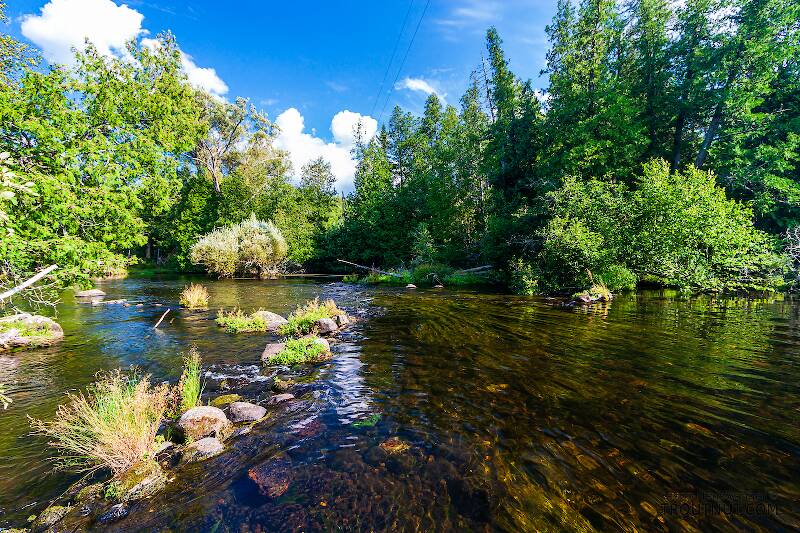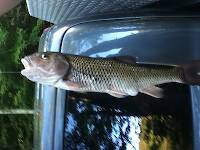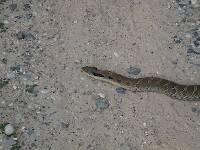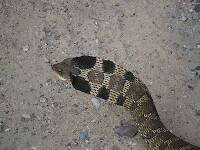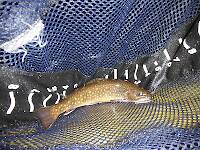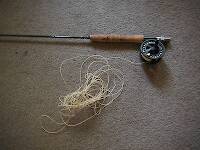
Blue-winged Olives
Baetis
Tiny Baetis mayflies are perhaps the most commonly encountered and imitated by anglers on all American trout streams due to their great abundance, widespread distribution, and trout-friendly emergence habits.
Featured on the forum

Troutnut is a project started in 2003 by salmonid ecologist Jason "Troutnut" Neuswanger to help anglers and
fly tyers unabashedly embrace the entomological side of the sport. Learn more about Troutnut or
support the project for an enhanced experience here.
Shawnny3 on Oct 2, 2011October 2nd, 2011, 8:10 am EDT
So I'm studying oceanography and meteorology right now, and a point made in my ocean text had me puzzled. It mentions that cartiligenous fishes are isoosmotic with their ocean environment, but that bony fishes are constantly consuming seawater and pumping out ions to maintain a relatively low internal osmolarity. Talk about effort! It made me wonder if anyone has researched a potential evolutionary path for ocean-living bony fishes.
Outside of any evidence at all, the following would seem most logical to me: All primitive fishes (and I suppose any ocean-borne organism) initially developed isoosmotically with their environment. As ocean-borne fish migrated over time into fresher and fresher water, they adapted isoosmotically to their new environment. Then, as these now fresh-water fishes began to migrate back into the ocean, they adjusted to the now high salt concentration in their new environment by acquiring the ability to pump ions. This path would mean that bony ocean fishes are descended from fresh-water ancestors.
The simpler path, of course, involves ocean-borne fishes developing the pumps directly as a means to alter their internal osmolarity because it conferred some advantage to them. But what sort of selective pressure would result in this change is beyond me, and it would be very strange for the dramatic pumping of ions to come about without some selective pressure. I feel like this explanation is simpler only on a superficial level. I'm not sure which idea Occam's razor would discriminate against, and in the absence of anything in the way of additional facts, I'm at a loss.
I'm hoping some of you fishy folks can shed light on this for me.
Thanks,
Shawn
Outside of any evidence at all, the following would seem most logical to me: All primitive fishes (and I suppose any ocean-borne organism) initially developed isoosmotically with their environment. As ocean-borne fish migrated over time into fresher and fresher water, they adapted isoosmotically to their new environment. Then, as these now fresh-water fishes began to migrate back into the ocean, they adjusted to the now high salt concentration in their new environment by acquiring the ability to pump ions. This path would mean that bony ocean fishes are descended from fresh-water ancestors.
The simpler path, of course, involves ocean-borne fishes developing the pumps directly as a means to alter their internal osmolarity because it conferred some advantage to them. But what sort of selective pressure would result in this change is beyond me, and it would be very strange for the dramatic pumping of ions to come about without some selective pressure. I feel like this explanation is simpler only on a superficial level. I'm not sure which idea Occam's razor would discriminate against, and in the absence of anything in the way of additional facts, I'm at a loss.
I'm hoping some of you fishy folks can shed light on this for me.
Thanks,
Shawn
Jewelry-Quality Artistic Salmon Flies, by Shawn Davis
www.davisflydesigns.com
www.davisflydesigns.com
Troutnut on Oct 2, 2011October 2nd, 2011, 11:52 am EDT
Check out this page on Google Books:
http://books.google.com/books?id=5GamlT7UCHYC&lpg=PA42&ots=BkHmX4XQTU&dq=ostracoderms%20osmoregulation&pg=PA42#v=onepage
It seems the situation is a little more complicated than you've described, but the answer to your question of selective pressure seems to be just speculation that it may have had to do with anadromous breeding.
I would also suppose that osmoregulation could have evolved in fish that lived near brackish water, especially places where rivers dump large volumes of nutrient-rich fresh water into the ocean and subsidize huge plankton blooms (a great food resource for fish) in a region with highly variable salinity.
http://books.google.com/books?id=5GamlT7UCHYC&lpg=PA42&ots=BkHmX4XQTU&dq=ostracoderms%20osmoregulation&pg=PA42#v=onepage
It seems the situation is a little more complicated than you've described, but the answer to your question of selective pressure seems to be just speculation that it may have had to do with anadromous breeding.
I would also suppose that osmoregulation could have evolved in fish that lived near brackish water, especially places where rivers dump large volumes of nutrient-rich fresh water into the ocean and subsidize huge plankton blooms (a great food resource for fish) in a region with highly variable salinity.
Jason Neuswanger, Ph.D.
Troutnut and salmonid ecologist
Troutnut and salmonid ecologist
GONZO on Oct 2, 2011October 2nd, 2011, 8:54 pm EDT
Shawn,
Here's one (fairly straightforward) explanation:
http://www.ca.uky.edu/wkrec/VertebrateFishEvolution.pdf
Here's one (fairly straightforward) explanation:
http://www.ca.uky.edu/wkrec/VertebrateFishEvolution.pdf
Shawnny3 on Oct 3, 2011October 3rd, 2011, 9:29 am EDT
Thanks, Gonzo - interesting stuff. I'd like to read what Jason intended to link to, as well.
-Shawn
-Shawn
Jewelry-Quality Artistic Salmon Flies, by Shawn Davis
www.davisflydesigns.com
www.davisflydesigns.com
Troutnut on Oct 3, 2011October 3rd, 2011, 12:53 pm EDT
Okay Shawn, I fixed it. It's a little bug in this site, apparently -- the code that parses links was messing up some of the capitalization in a case-sensitive address, so you have to just copy and paste it.
Here it is again: http://books.google.com/books?id=5GamlT7UCHYC&lpg=PA42&ots=BkHmX4XQTU&dq=ostracoderms%20osmoregulation&pg=PA42#v=onepage
Here it is again: http://books.google.com/books?id=5GamlT7UCHYC&lpg=PA42&ots=BkHmX4XQTU&dq=ostracoderms%20osmoregulation&pg=PA42#v=onepage
Jason Neuswanger, Ph.D.
Troutnut and salmonid ecologist
Troutnut and salmonid ecologist
Entoman on Oct 3, 2011October 3rd, 2011, 5:20 pm EDT
Fascinating link Lloyd - particularly interesting to learn that all vertebrates have the same salt content in their blood. The possible explanation for this and how the oceans got salty is very cool.
Kurt
Kurt
"It's not that I find fishing so important, it's just that I find all other endeavors of Man equally unimportant... And not nearly as much fun!" Robert Traver, Anatomy of a Fisherman
Entoman on Oct 3, 2011October 3rd, 2011, 5:24 pm EDT
BTW - Never seen it mentioned before, but it seems that the increasing salinity of our oceans is a greater threat to life than the sun running out of gas (give or take a few hundred million years or so) :).
"It's not that I find fishing so important, it's just that I find all other endeavors of Man equally unimportant... And not nearly as much fun!" Robert Traver, Anatomy of a Fisherman
Shawnny3 on Oct 8, 2011October 8th, 2011, 8:25 am EDT
Thanks, Jason. Interesting stuff.
-Shawn
-Shawn
Jewelry-Quality Artistic Salmon Flies, by Shawn Davis
www.davisflydesigns.com
www.davisflydesigns.com
Quick Reply
Related Discussions
Topic
Replies
Last Reply
Re: 15 Pound Steelhead (Trout) caught in Bosnia (Slideshow & Videos included)
In Fishing Reports by IvansFishin
In Fishing Reports by IvansFishin
4
Jan 27, 2017
by IvansFishin
by IvansFishin
3
Dec 10, 2015
by PaulRoberts
by PaulRoberts
Re: Clinger nymphs are shaped that way to hang in really fast currents. Really? Featured Topic
In the Mayfly Genus Rhithrogena by Entoman
In the Mayfly Genus Rhithrogena by Entoman
14
Jun 14, 2017
by Steamntrout
by Steamntrout
4
Jul 14, 2016
by Jmd123
by Jmd123

